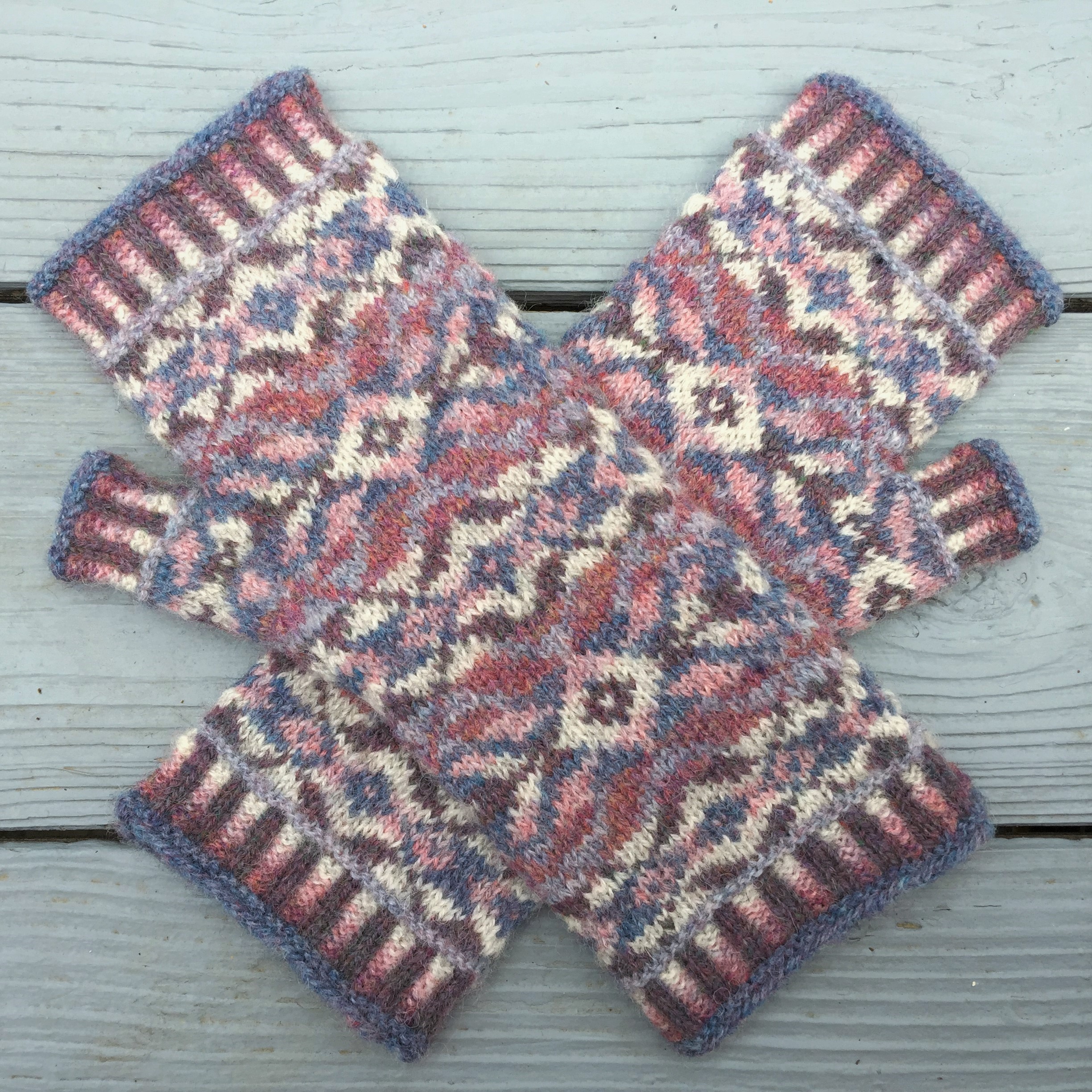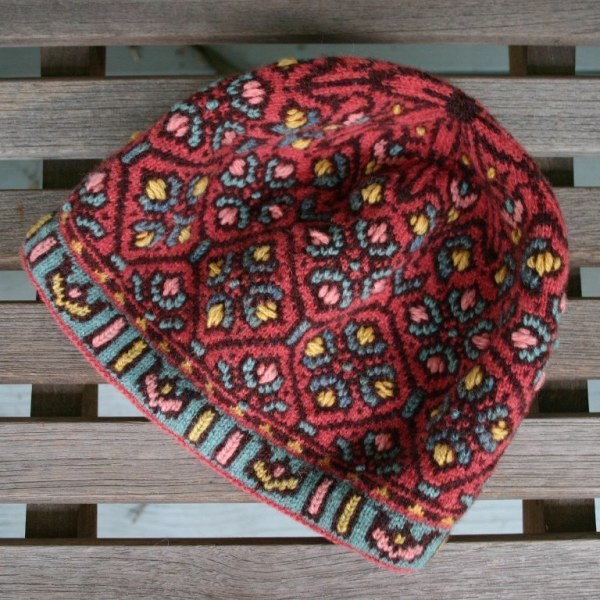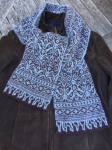Dale of Norway has an extraordinary number of beloved designs for children, but I guess the most beloved of all would have to be their “Marihone”, or “Ladybug”, sweater.
I have more than a few customers whose first reaction, upon hearing that someone is expecting a baby, is to order up yet another batch of Dale Baby Ull yarn for yet another baby-shower-show-stopping Ladybug sweater. The original lively colors and adorable motif work well for any little lovebug, male or female. Yet lately, as more mothers happily broadcast the sex of their little bundle months before the stork makes his delivery, I’m getting more requests for girly colorwork Dale designs. Actually, they have quite a few of them, but I really liked the idea of combining an all-time favorite with some of their more girly shades of Baby Ull to come up with my own “Girlybug” colorway.
I’ve charted these pastel shades out so that they correspond with the colorway color numbers in the Dale of Norway “Marihone” pattern. If you’re using one of the original, out-of-print patterns, you’ll see they number the shades “MC, CC1 thru CC6”; if you’re using the current Book 8102, you’ll see they number those same charted values as “color 1 thru color 7”. Either rendition will work with my colors, below:


















I’m currently knitting this pattern and found that it doesn’t tell you how many inches to knit before doing the armholes. Can you help me with this?
In a traditional Norwegian sweater such as this, nothing is done for the armholes until the entire body, from the bottom hem to the top of the neckline, has been knit as one simple tube and both sleeves have been completed. Only after you have all of those pieces together do you mark the armholes (which, at that point, you know you can size perfectly) and sew and cut accordingly. You can find a detailed explanation of Norwegian “steeks”, or “cutting stitches” (as they’re apt to be called in a Dale pattern) here on my kidsknits.com retail site: http://www.kidsknits.com/steeks_introduction.html Have fun!
I am stumped at the neck openings. Can you please help me?
Hopefully! What part has you stumped?
At the Front Neck Opening, you bind off the neck opening and work to the end of the round. Then, cut yarns and slip left front shoulder stitches from left needle to right needle? Reattach yarns and begin working back and forth. I’m lost.
Your current end of the round is at the left shoulder. The directions you’ve quoted are simply the necessary steps to shift the end of the round to the neck edge so that you can then knit back and forth, from one neck edge to another. If you didn’t shift the end of the round, you’d have one side of the front neck on one round and the rest of the sweater on a different round – a sure prescription for misery! So, follow those steps and, although they might sound odd, they’ll work out just fine. If there’s something particular within those steps that you don’t know how to do, just say so; otherwise, keep going – you’ll do fine! 🙂
Okay. I have slipped the left front shoulder stitches to the right needle. Now, do I turn and go backwards (purl) or go forward and knit? Sorry, I must sound kinda dumb here.
You sound perfectly fine! 🙂 Now you’re set up to knit back and forth, from one neck edge to the other. You can do that by knitting on the right side and purling back on the wrong side – that’s the most common approach. Or…you can stay on the right side and, once your knitting gets to the far-left edge of the knit row, without turning your knitting, you can go left to right by “knitting back backwards” – a little-known, but very valuable, technique for staying on the right/front side of your work so that it’s easier to visually relate the chart to your knitting – strands on the wrong side can really hide complicated charted details! But, if you’re doing the Dale Marihone (ladybug) pattern referenced in this blog post, the chart details are pretty simple, so you shouldn’t have too much trouble purling back on the wrong side. Still, someday, when you have a moment, check out “knitting back backwards” – it’s priceless for getting through this same process on more complicated charts.
You have been so helpful. I appreciate your help. I have never really gotten into knitting backwards, even when I did an entrelac scarf. In considering my next project, I find that Baby Ull is no longer available. Are you happy substituting Eco Baby Wool for Baby Ull?
Eco Baby Wool is lovely, but it’s not the same thing as Baby Ull. For some projects, it could be a fine substitute (as long as you’re aware of the differences and treat your project accordingly.) In some cases, it could actually be a lovely improvement. Then again, in some cases, it could be a disastrous choice. It pays to appreciate the differences!
Baby Ull is a superwash merino that is now made in China; Eco Baby Wool is an organic, traditional wool from Italy. So, you can throw superwash Baby Ull items in the washing machine, if you’re so inclined; but, if you do that to Eco Baby Wool, you might be sorry – it’s apt to felt/shrink – you’ll want to hand wash Eco Baby Wool. (Actually, I understand it felts nicely, if that’s what you’re looking for.) Both of them should be dried flat. Baby Ull is slightly softer, but Eco Baby Wool is quite soft, for a traditional wool, and traditional wools are typically warmer and more durable than merino wools. There’s a slight, but definite gauge difference between Baby Ull and Eco Baby Wool: Baby Ull’s ball band gauge is 8 sts/inch; Eco Baby Wool’s ball band gauge is 7 sts/inch. With smaller needles, it can compress nicely to Baby Ull’s 8 sts/inch gauge (and beyond) but remember that compression stiffens up the drape. That’s fine – downright desirable – for things like hats & mittens, where you can use the extra warmth, durability and thickness. On the other hand, it might not be what you want for a lace dress!
As you can see, while I like Eco Baby Wool, I wouldn’t call it a 1:1 substitute for Baby Ull. But it’s lovely and close enough – for SOME projects, as long as you plan accordingly.
This comparison is VERY helpful. I am wanting to knit a Dale of Norway romper set, and don’t like the idea of a yarn felting. Is the Baby Ull from China available, and can you get it?